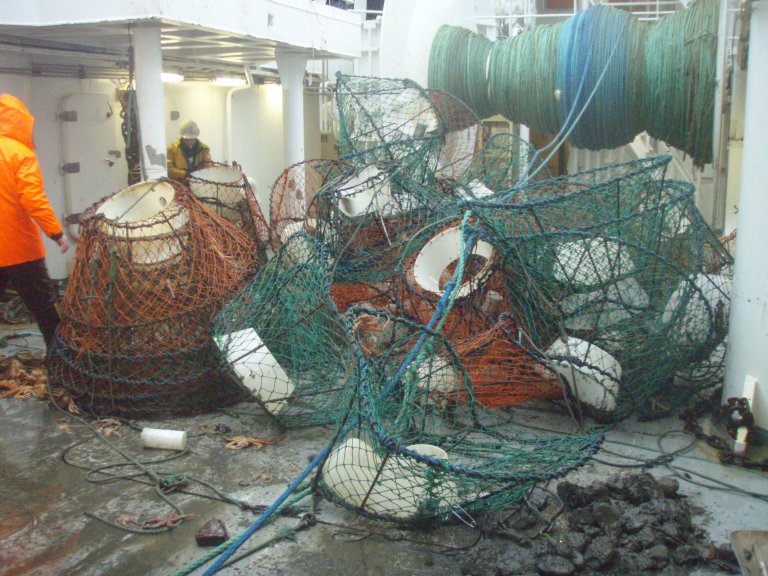Lost fishery equipment removed from the seabed
The Norwegian Directorate of Fisheries has been conducting annual clean-up expeditions of discarded and abandoned fishery equipment for almost 40 years. This contributes towards reducing ghost fishing and helps to reduce marine littering.
At our last expedition – in August and September 2020 - approximately 100 tonnes of lost and discarded fishery equipment and fishing gear was removed during a clean-up expedition between Ålesund and Svalbard. We have never before covered such a large area.
Marine littering is an environmental problem, which we must solve as a matter of urgency. We cannot allow fishing equipment to remain on the seabed and continue to catch fish over long periods. This litter our waters and leads to a high mortality rate among fish and shellfish. Both professional and recreational fishermen must become even more diligent at reporting lost equipment.
The amount of fishing equipment removed is huge, but not exceptionally so in relation to the scale of the expedition. There is no ban against losing fishing gear, but it is illegal not to report the loss.
At a time of great awareness towards marine littering, it is sad to see some fishermen obstruct fishing possibilities for others by leaving behind “forgotten” danish seine ropes and trawl wires, which are dumped on fishing grounds to the detriment of other types of fishing and equipment groups and which contribute towards the further loss of fishing equipment.
Considerable quantities
A total of 2669 pot traps were removed, including 2405 snow crab pots, 130 crayfish pots, 119 king crab pots and 15 brown crab pots. Around 700 gill nets of various different types were also removed, corresponding to approximately 20,000 metres of gill nets. About 172,450 metres of rope was removed, including 6,800 metres of danish seine rope and 39,000 metres of longline. In addition, hundreds of buoys and anchors were also found. More than 11,000 kg of fish was discovered in the nets, as well as more than 15,000 crabs.
With 4745 metres of wire being recorded, we have unfortunately detected an increase in the amount of wire being left behind or dumped. The seine and trawler components found were enough to fill 200 square metres. Parts of two smaller fishing vessels, a bow and a superstructure were also found caught up in fishing equipment.
The Directorates collaboration with fishers has been positive over the course of the expedition. Even though a large vessel with good storage capacity was used in the expedition, the work was nonetheless demanding, especially in the Greenland halibut fishing grounds in the north where weather conditions were very poor.
Lost gear in an interactive map
The map shows lost gear in specific locations. Clicking on the symbols will bring up results on screen.
Lost gear in an interactive map (opens in new window)
Reducing ghost fishing and seabed contamination
In addition to releasing thousands of crabs from pot traps, the removal of netting and traps in particular helps to considerably reduce the occurrence of ghost fishing. Equipment that is lost, discarded or dumped also represents an increased risk of snagging and thus the subsequent loss of new equipment. This is a vicious spiral that we are helping to break through our annual clean-up expedition.
Equally, in 2019 we also discovered a dead humpback whale, which had become caught in ropes attached to pot traps. A dead seal was also found in one of the pots.
Circular economy
Once more this year, pot traps and nets have been returned to owners who had reported them lost. However, this poses a challenge in terms of logistics and making arrangements for their return without hampering the expedition’s progress. Meanwhile, we are also recognising a clear need for the actual equipment to be labelled with an ID that can be unequivocally linked back to the rightful owner. This is an area that is being developed at present as part of a collaboration between the Directorate of Fisheries and SINTEF.
For almost ten years, the Directorate of Fisheries has worked in collaboration with NoFir to deliver salvaged equipment for recycling. The current international market situation for plastic recycling is difficult, however, as handling and removal are both costly processes. It has therefore been necessary to send a larger proportion than would be desirable to landfill this year.
Inadequate rope
Fishers are generally diligent at dimensioning their equipment in line with fishery type and operating conditions, but unfortunately this is not the case for all. Sinking rope and net rope, which is too thin or worn and inadequate for use in net fishing at great depths for Greenland halibut, is just one area where the fishers themselves need to take action to reduce the loss of fishing equipment.
It is also important that lost equipment be reported to the Coast Guard as soon as possible and that an accurate description is given. Should the fishers then succeed in recovering the equipment in a later attempt, it is important that this information also be reported.
Knowledge-sharing
Over time, Norway has developed a system for coordinating between fishers and official bodies that works well. Compliance with the requirement to report lost equipment is on the rise and the annual expeditions are helping to generate mutual trust in a functioning system, which yields positive results each year.
The Norwegian system functions so well that many other countries are seeking information on how it works, and Norway has helped by sharing its knowledge through the Clean Nordic Ocean project.
Take a look at the final report and policy brief from Clean Nordic Ocean (both at Nordic Council om Ministers).

 Norsk
Norsk
